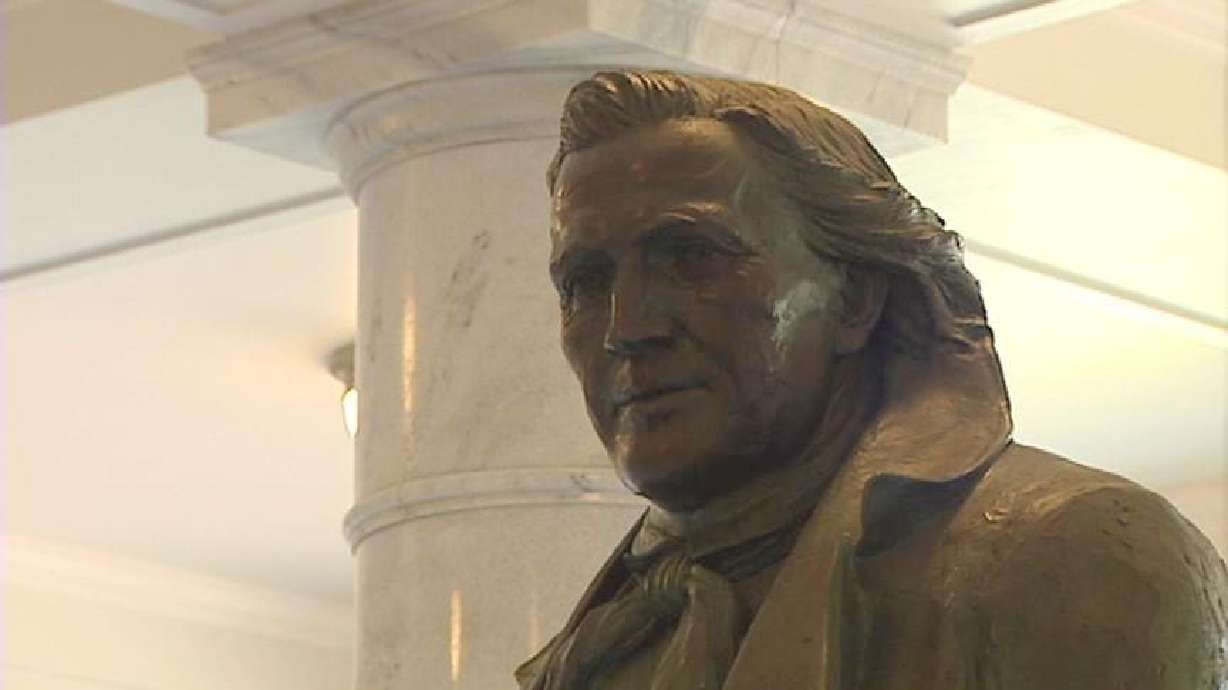Estimated read time: 3-4 minutes
This archived news story is available only for your personal, non-commercial use. Information in the story may be outdated or superseded by additional information. Reading or replaying the story in its archived form does not constitute a republication of the story.
SALT LAKE CITY (AP) -- Brigham Young is widely known as the polygamist leader of the Mormon church who established a theocracy here in 1847 after fleeing religious persecution in Illinois.
But don't look for many signs of that at the Utah Capitol, where a 10-foot-tall, 1,500 pound statue of the former territorial governor was put on display Friday after more than four years in storage during renovation of the Capitol.
Instead, a three-sentence biography makes only a passing reference to the state's early conflict with the federal government over polygamy and Young's role in it. "Acting on rumors that the Mormons were rebelling against federal authority, (President) James Buchanan replaced Young as governor in 1857," the biography reads in part.
There's no mention of Young's 56 wives or the preparations he made to go to war against federal troops who came to install a new governor and quash polygamy. The church abandoned polygamy in 1890 as a condition of statehood and excommunicates members found practicing it, but plural marriage continues among some splinter sects.
The Legislature commissioned the statue in 1992 to honor Young and it recognizes him as "the American Moses" for leading faithful Mormons into Utah following the murder of church founder Joseph Smith in 1844 in Carthage, Ill.
Monuments and statues placed on public land around the country are often sensitive subjects where information that's left out can be just as important as what's included.
Last month, a South Carolina lawmaker unsuccessfully fought to have a statue of former governor and U.S. Sen. "Pitchfork" Ben Tillman removed from statehouse grounds after complaining it ignored his racist past.
The text on the statue reads "Loving them he was the friend and leader of the common people."
However, on the Senate floor, Tillman in 1900 said, "We of the South have never recognized the right of the Negro to govern white men, and we never will. We have never believed him to be equal to the white man, and we will not submit to his gratifying his lust on our wives and daughters without lynching him. I would to God the last one of them was in Africa and that none of them had ever been brought to our shores."
Those in favor of leaving the statue said there was no need to rehash the past. Judith McConkie, curator of the Utah Capitol, said Utah isn't trying to ignore or hide any of Young's history. She said it's just more complex than a small display on territorial governors allows. "It's a complicated history and the hard thing is to make it make sense in three small cases," she said. "It's a hard job to kind of consolidate it down. It doesn't mean I'm going to walk away from it. It's just how do I explain it so it's accurate and feasible, particularly for every grade school child that comes through here?"
To that end, McConkie said that late this summer the state will make a virtual tour of the Capitol with downloadable documents available online to give a broader history of paintings, monuments and governors. "So if you want to know something about Brigham as territorial governor, that'll be available," she said. "It allows us to share this building with more people. Before that time, for much of the history, people would search all over the place and find bits here and bits there. This is one place you can find those documents."
A Web site might help visitors to the Capitol like Wolfgang Pfingst, a tourist from Gernsbach, Germany, who was visiting the Capitol with his wife and son Friday when the statue of Young was being placed.
He says he's been in Utah four days as part of a tour of American West, but had heard very little about Young's polygamous past. "I know that he was the leader of the Mormons and the founder of this town," he said. "He was important because he was one of the first settlers."
(Copyright 2008 by The Associated Press. All Rights Reserved.)









